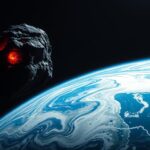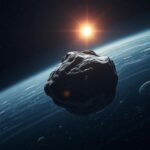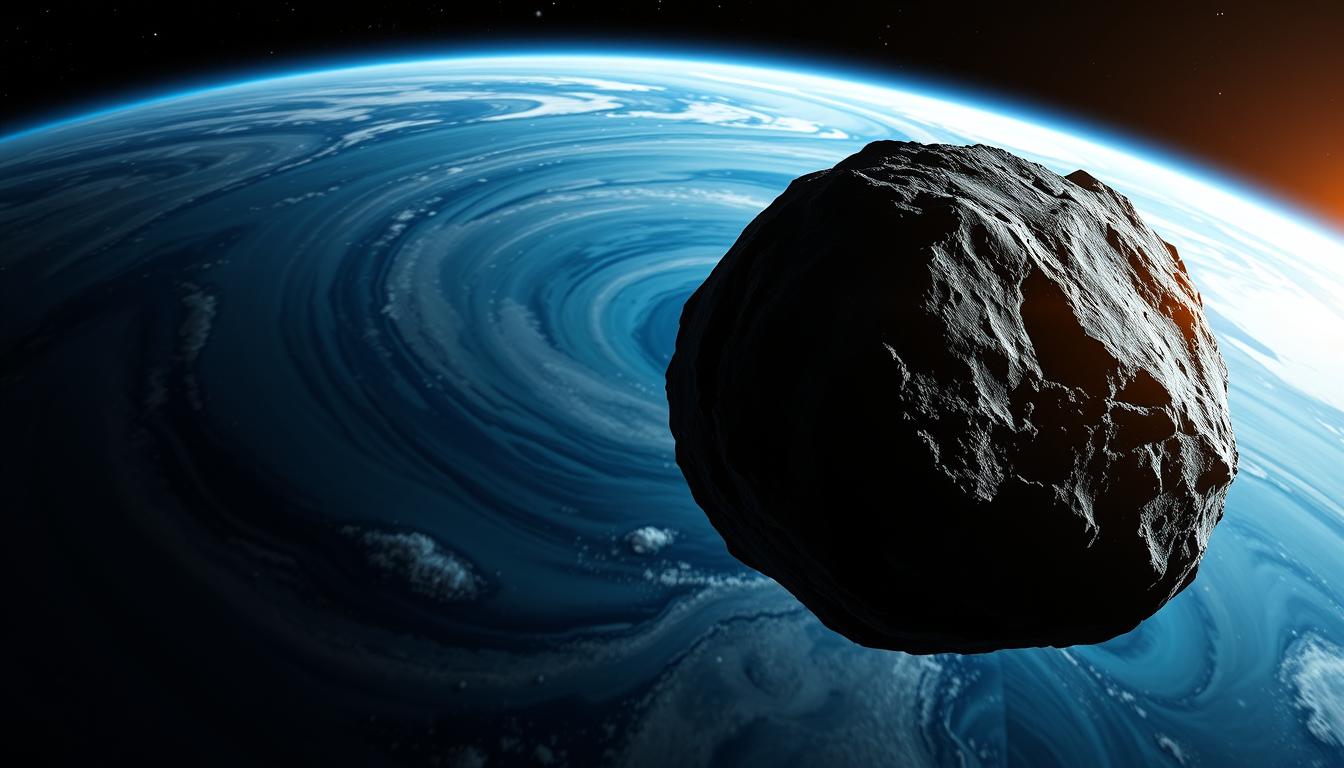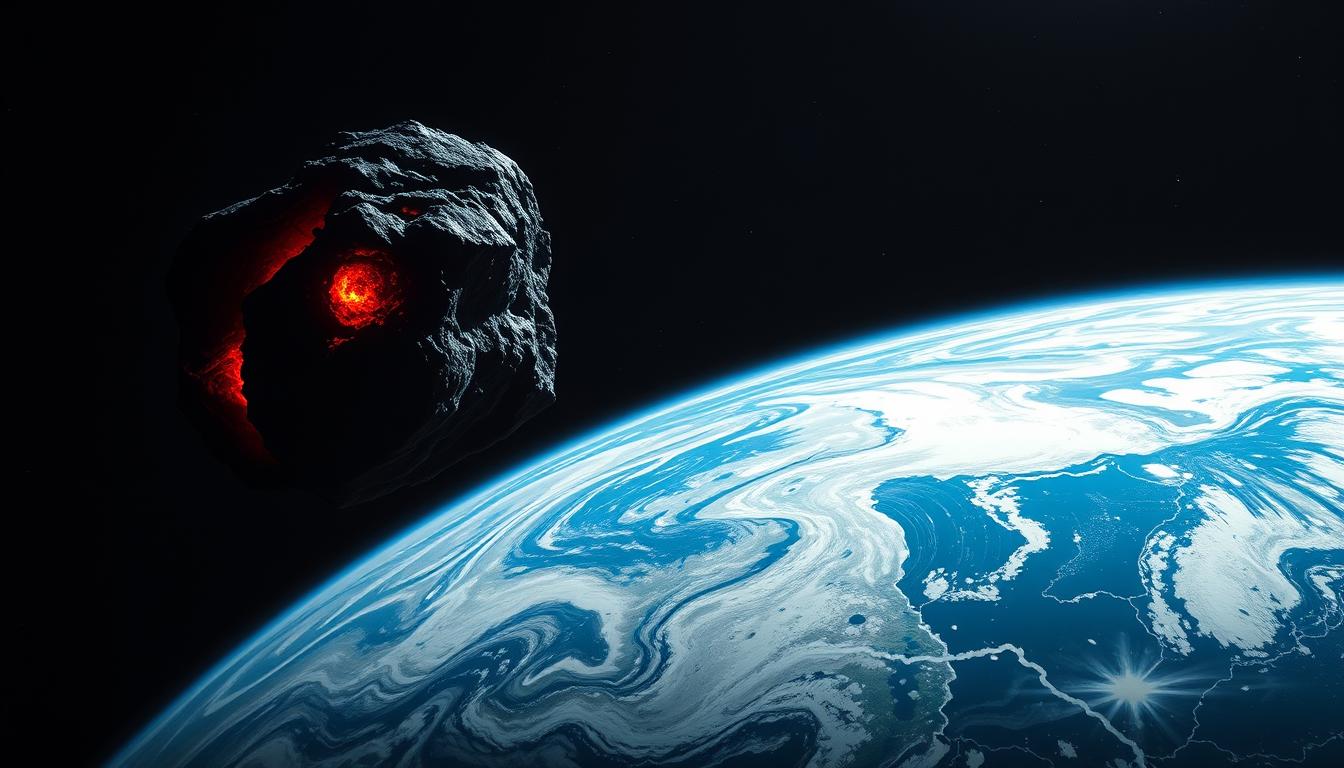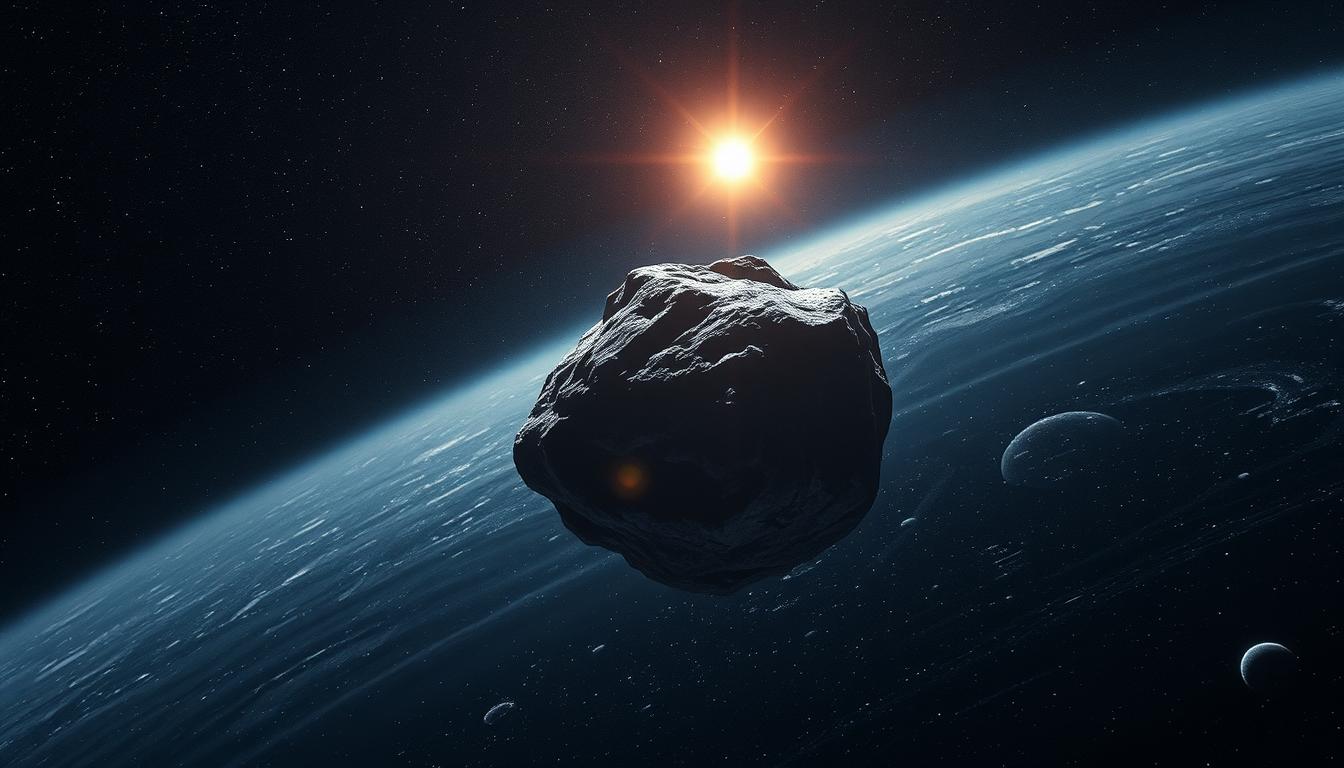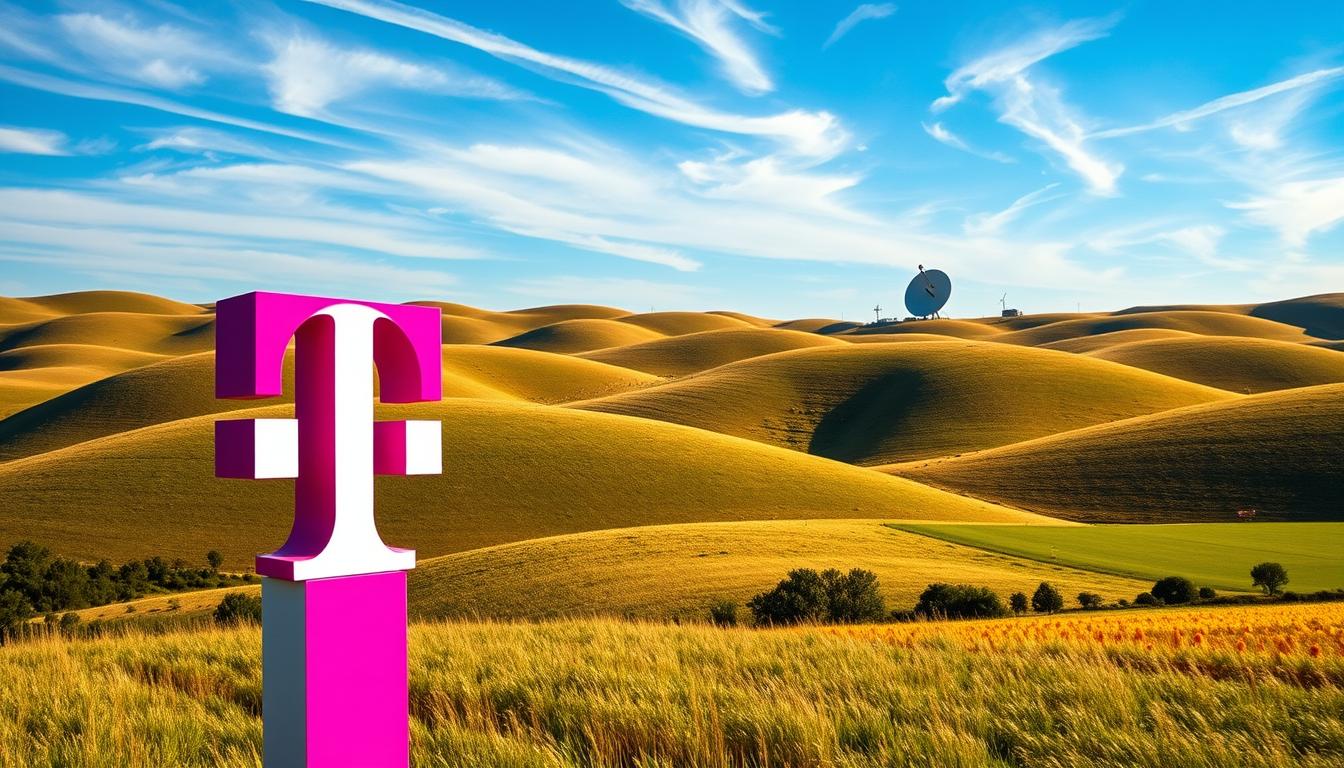I’ve always been drawn to the way Earth and asteroids interact. The discovery of asteroid 2024 YR4 has caught everyone’s eye. It’s a reminder of the importance of protecting our planet from space rocks1.
NASA and the European Space Agency are watching asteroid 2024 YR4 closely. They say there’s a 1.2% chance it could hit Earth in 2032. But, there’s a 99% chance it will miss1.
This asteroid is big, between 131 and 328 feet wide. If it hits, it could cause a lot of damage. Right now, it’s 28 million miles away, and scientists are tracking it very closely12.
Key Takeaways
- Asteroid 2024 YR4 has a 1.2% chance of impact in 2032
- Scientists are closely monitoring the near-earth object
- The asteroid is between 131 and 328 feet wide
- Current distance from Earth is 28 million miles
- 99% probability exists for the asteroid to pass safely
Discovery of Asteroid 2024 YR4: A New Potential Threat
The world of near-earth object monitoring has been stirred by the recent discovery of Asteroid 2024 YR4. This space rock has caught the attention of planetary defense experts. It represents a significant challenge in hazardous asteroid mitigation, triggering intense scientific scrutiny3.
![]()
First Detection by Advanced Telescope
The Asteroid Terrestrial-impact Last Alert System (ATLAS) telescope in Chile first detected this potential threat on December 27. This marked a crucial moment in asteroid early warning systems4. The asteroid’s initial characteristics are particularly noteworthy:
- Size range: 130 to 300 feet (40 to 90 meters)3
- Current impact probability: 1.3%5
- Potential impact date: December 22, 20323
Risk Assessment and Classification
Scientists have classified Asteroid 2024 YR4 with a Torino Impact Hazard Scale value of 3. This indicates a close encounter requiring serious attention5. This rating sets it apart from most near-Earth objects, as it is currently the only asteroid with a rating above 13.
The discovery underscores the critical importance of continuous sky monitoring and advanced detection technologies in planetary defense.
Current Tracking Status
Ongoing observations suggest the asteroid will become increasingly challenging to track. Predictions indicate it will be invisible after April 2024 until its reappearance in 20284. Researchers continue to refine their calculations. They understand that initial high-risk assessments often get revised as more data becomes available5.
Understanding the Asteroid’s Physical Characteristics
Tracking potentially hazardous asteroids is a big job for scientists. Asteroid 2024 YR4 is a big challenge for researchers. It’s about 60 meters wide and could cause a lot of damage if it hits Earth6.
- Current distance from Earth: 44 million kilometers6
- Speed: 13.5 km/s6
- Mass: 220 million kilograms7
- Potential impact probability: 1-in-836
Scientists study the asteroid’s makeup and path to predict its danger. Its high ranking on the Torino impact scale is very worrying6.
The scale of potential destruction could be comparable to the historic Tunguska event, which devastated a large region of Siberia7.
The data shows the asteroid could cause a lot of damage. It could blast an area about 50 kilometers wide7. Its unique features make it a key focus for scientists and defense plans.
Probability Analysis: Asteroid Hitting Earth 2032
Tracking space objects gives us important clues about Asteroid 2024 YR4’s risks. Scientists are carefully studying the asteroid’s chance of hitting Earth8.
Impact Probability Statistics
The asteroid’s chance of hitting Earth is very low. It has a 1.2% chance of hitting on December 22, 20328. But there’s almost a 99% chance it won’t hit9.
- Probability of impact: 1 in 839
- Torino Impact Hazard Scale rating: 39
- Potential energy release: 8 megatons9
Risk Assessment Methodologies
Scientists use advanced methods to check asteroid threats. They keep updating the asteroid’s risk with new tracking tech and data10.
The probability of impact changes and is always being checked by scientists.
Timeline of Probability Changes
Recent updates show small changes in the impact chance. The chance has gone up from one-in-83 to one-in-77. This shows how accurate modern tracking is10.
- Initial detection: December 27, 20228
- Current distance: About 28 million miles from Earth8
- Next close observation window: 202810
Keeping a close eye on it is key to understanding this possible event8.
Orbital Path and Trajectory Predictions
Tracking the complex orbital path of this near-earth object reveals fascinating insights into its potential space rock collision trajectory. The asteroid 2024 YR4 follows an elongated, eccentric orbit. It takes it through remarkable celestial pathways11. Its current path moves away from Earth in an almost straight line, creating unique challenges for astronomers monitoring potential impact scenarios12.
The asteroid’s orbital dynamics present intriguing characteristics:
- Diameter ranges between 40-90 meters7
- Currently traveling at 17.32 km/s7
- Ranked 3 on the Torino Impact Hazard Scale11
Astronomical observations indicate the asteroid’s visibility will alternate. Tracking is possible until April and then becomes unobservable until 20287. This intermittent visibility creates significant challenges for precise asteroid deflection strategies12.
The uncertainty in predicting trajectories remains high, especially for near-earth objects with complex orbital paths.
The current impact probability stands at approximately 1.3%. This means there’s a 1-in-100 chance of collision with Earth in 2032711. While the odds seem low, scientists continue monitoring this potential space rock collision with utmost attention12.
Potential Impact Scenarios and Consequences
The possibility of a catastrophic impact from Asteroid 2024 YR4 is alarming. While the chances are low, the potential consequences are serious. Asteroid 2024 YR4 has a 1.2 percent chance of hitting Earth on December 22, 2032. It’s the only near-Earth asteroid with an impact probability above 1 percent13.
Local and Regional Impact Effects
The devastation could be huge. An impact would be like a 10-megaton bomb, causing widespread destruction. The asteroid, estimated to be 40 to 100 meters in size, could incinerate everything within 3 to 4 kilometers. It could also cause severe damage up to 10 kilometers away14.
- Potential destruction radius of up to 10 kilometers
- Massive ground zero incineration zone
- Significant regional infrastructure collapse
Comparison to Historical Events
Looking at history gives us important lessons. The 1908 Tunguska event is a chilling example. An asteroid flattened 500,000 acres of forest, an area about 34 times the size of Manhattan15. This event shows the potential for global devastation from cosmic encounters.
“The sky was split in two, and high above the forest, the whole north part of the horizon was lit up.” – Eyewitness account of the Tunguska event
Environmental Impact Projections
An asteroid strike would have devastating environmental effects. It could disrupt the climate, change the atmosphere, and cause long-term ecological damage. With the asteroid classified as Level 3 on the Torino Impact Hazard Scale, scientists are closely watching its path13.
Despite these risks, there’s a 99 percent chance Asteroid 2024 YR4 will miss Earth14. Keeping a close eye on it and working together internationally is our best defense.
NASA’s Monitoring and Tracking Systems
I take you into the world of near-earth object monitoring. NASA’s Jet Propulsion Laboratory (JPL) is key in tracking dangerous space objects. The Asteroid Watch program scans the skies for threats to our planet4.
Asteroid early warning systems use a network of technologies and observatories. NASA has over a hundred telescopes scanning the sky16. These systems work hard to find and analyze near-Earth objects that could be risky.
- Ground-based telescopes provide initial detection
- Space-based observatories offer complementary tracking
- Sophisticated computer algorithms analyze trajectory data
The International Asteroid Warning Network (IAWN) is a global effort. It brings together space agencies to improve our defense16. By sharing data and resources, scientists can better predict and prevent asteroid impacts.
Our vigilance in space object tracking could be the difference between planetary safety and potential catastrophe.
NASA must find asteroids over 450 feet that could cause big damage16. The JPL Asteroid Watch program keeps an eye on asteroids close to Earth. This ensures we’re ready and informed about cosmic threats4.
International Collaboration in Asteroid Defense
Planetary defense is now a top global priority. The world’s best space agencies are working together like never before. This is because of growing concerns about asteroid threats17.
Assessing global asteroid risks needs a team effort. Two leading groups are at the heart of this mission:
- International Asteroid Warning Network (IAWN), chaired by NASA
- Space Mission Planning Advisory Group (SMPAG), led by the European Space Agency
European Space Agency’s Pivotal Role
The European Space Agency is key in global defense plans. Their advanced tracking and research have boosted our ability to face asteroid risks18.
Global Observatory Network
A global network of observatories tracks asteroids together. This teamwork ensures we can watch and share info on asteroids fast19.
Data Sharing Protocols
New data sharing rules help space agencies talk fast. These rules make sure we can share info quickly, helping us defend our planet17.
Our strength lies in our collective ability to respond to potential cosmic threats.
Together, international teams are building a strong defense. They use all their skills and tech to protect our planet from asteroids19.
Planetary Defense Technologies and Strategies
Protecting our planet from asteroids needs advanced technologies. NASA’s work in asteroid deflection has changed how we handle threats14. The DART mission showed a big step forward in moving dangerous space objects20.
- Kinetic Impact Technique: Crashing spacecraft into asteroids
- Gravity Tractor Method: Changing asteroid path with gravity
- Ion Beam Deflection: Applying gentle pressure to change direction
“Our ability to detect and potentially redirect asteroids represents humanity’s most sophisticated planetary defense strategy.” – NASA Planetary Defense Specialist
An asteroid like 2024 YR4 could cause huge damage. It’s between 40 and 100 meters wide14. If it hits, it could be as bad as a 10-megaton bomb14.
Now, we’re working on finding asteroids early and acting fast. NASA and the European Space Agency are watching for threats20. The Space Mission Planning Advisory Group is making plans to deal with asteroids14.
The future of planetary defense depends on new tech and working together worldwide.
DART Mission Success and Its Implications
The Double Asteroid Redirection Test (DART) mission is a major step forward in protecting Earth from asteroids. It showed a new way to deflect asteroids by crashing a spacecraft into one. This was the first time humans intentionally changed an asteroid’s path21.
Key mission details highlight its remarkable success:
- The spacecraft hit Dimorphos at 14,000 mph21
- Orbital period was reduced from 11 hours and 55 minutes to 11 hours and 23 minutes21
- The mission exceeded minimum requirements by changing the asteroid’s orbit by 4.5%21
Telescopes like Webb and Hubble captured the impact’s details21. The spacecraft kicked up about 1 million kilograms of rock from Dimorphos. This was about 0.023% of its total mass22. The rock’s momentum was almost four times the spacecraft’s impact force22.
“This mission proves we can potentially protect our planet from asteroid threats through precise technological interventions.”
The mission cost $325 million21, a small price for such a groundbreaking experiment. The European Space Agency’s Hera mission will study the DART impact’s effects in 202622.
Future Observation Windows and Research Plans
The upcoming look at Asteroid 2024 YR4 is a big deal for tracking near-earth objects. Scientists are getting ready for a deep dive into research. This will help us learn more about this possible danger23. They say the asteroid will be visible again in 2028, giving us a chance to track it better23.
- Next-generation telescopes with better tracking
- International teams working together
- Using advanced models to track the asteroid
Advanced Telescope Deployment Strategy
Early warning systems for asteroids are getting better. With a 1.3 percent chance of hitting Earth24, scientists are focusing on top-notch tech. A new telescope network will use the latest in imaging and tracking to get detailed info on the asteroid23.
Our goal is to reduce uncertainties and provide the most accurate assessment possible of Asteroid 2024 YR4’s potential threat.
The plan includes detailed studies, orbit updates, and constant watching. Precision is key in understanding potential near-earth object risks23.
NASA Asteroid Tracking Report24European Space Agency Asteroid Risk Assessment
Conclusion
Reflecting on Asteroid 2024 YR4, I see it as a minimal threat. It has a small chance of hitting Earth in 20322526. Thanks to advanced planetary defense, we can track and possibly prevent cosmic dangers25.
Global scientific teamwork is key in asteroid emergency planning. NASA and the European Space Agency keep a close eye on near-Earth objects. They analyze data to lower the risk of impact25. Experts like Andrew Rivkin believe our tracking will get better, making the risk of impact zero.
Our tech for finding and possibly moving asteroids has never been better. The DART mission shows we can change an asteroid’s path25. Even though Asteroid 2024 YR4 is unlikely to hit us, our readiness shows our dedication to protecting the planet and advancing science.
Looking ahead, we need to keep investing in space tech and working together globally. Understanding and dealing with cosmic threats is a never-ending scientific quest. Each new discovery brings us closer to understanding our solar system’s complex ways.


